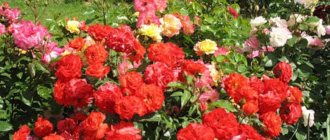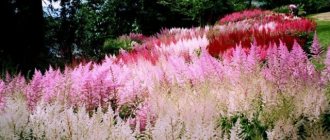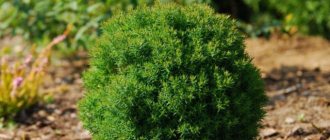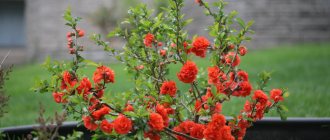Teddy
This variety appeared quite recently and has already gained unprecedented popularity. It's all about his amazing appearance. Thanks to its dense and lush crown, this spherical thuja variety looks like a bright pillow. In addition, Teddy is the fluffiest and softest variety, and therefore is in demand even despite the fact that it is considered quite capricious. The evergreen dwarf grows slowly, at the age of ten its height is no more than 30 cm and its width is 40 cm.
Among Teddy's advantages, one can note its tolerance to shaded areas - a couple of hours spent under the sun's rays is enough for this variety. At the same time, the plant needs regular watering, otherwise the needles will turn yellow. To ensure that Teddy's thuja branches grow evenly, you should not overfeed the bush.
This spherical variety of thuja is perfect for creating stone gardens and alpine slides. It is important to take into account the change in color of the needles at different times of the year - in the fall, Teddy changes its rich green hue to bronze. This variety combines with other thujas, lush flowers and ornamental shrubs. In addition, Teddy is suitable for placement on verandas, balconies and even in rooms! Green thuja will add color and freshness to any interior.
Varieties of spherical beauty
Golden Globe is a very beautiful thuja that can often be found decorating terraces. Its needles are golden in color, and in the fall they begin to cast copper. This beauty grows slowly; it can be planted on a loggia or on the roof. To grow thuja, you need to provide it with moist air.
Danica is a miniature (up to 50 cm) thuja. Its needles remain green all year round. And the bark has a red-brown tint. Can be planted in small areas.
Tiny Tim is a spherical thuja with feather-like leaves. It is recommended to plant in groups. It is unpretentious in terms of soil, but needs sun.
Globoza - reaches one and a half meters in height. The needles, depending on the season, are green and green-brown. Moisture-resistant plant.
Miriam has a bright green crown in the spring. Features a symmetrical shape. Loves sun and regular watering. This variety is most suitable for creating a Japanese garden.
Teddy is a unique variety that was recently bred. The crown is dense and dense. A rather capricious variety: it does not like dry air, is picky about the type of soil, and needs constant feeding. It grows slowly and turns brown in winter.
Woodwardie is an unpretentious variety. Grows well in a shaded place. Forms small bumps.
Danica
This variety was bred in 1948 in Denmark. It can be called one of the most compact representatives of spherical thujas. It grows slowly - the annual increase in height is about 5 cm, in width - 4 cm. In ten years, with proper planting and care, Thuja Danika can grow up to 50 cm, and its diameter will not exceed a meter!
One of the main advantages of this variety is its unpretentiousness. Danica thrives in shaded areas; it also grows in direct sunlight. The only thing that thuja will not tolerate is proximity to groundwater. In this case, the plant must receive enough moisture. It is better to choose fertile soil. How to care and plant Thuja Danika? Firstly, you need to select shoots with a strong root system, without damaged roots. A layer of crushed stone should be laid out in the planting hole. By the way, it is worth planting the plant in the spring - over the summer the root system will develop, the thuja will strengthen and overwinter without any problems. Before the onset of cold weather, it is worth covering the young shoots with burlap. After each watering, coniferous shrubs must be loosened and mulched once a year. Gardeners recommend pruning Danica in early spring. Damaged, dry branches should be removed.
In garden design, thuja of this spherical variety can be combined with other shrubs of the same shape. Group plantings look organic. Of course, such a hedge will not become an obstacle to prying eyes, but will add coziness and completeness to the garden!
Planting and care
Proper planting and care of the thuja globulus in the garden are prerequisites for the good development of the tree.
When and where to plant?
When choosing a planting site, give preference to partial shade. In the shade, the plant will lose its decorative qualities, the crown will become sparse, and the branches will stretch out. In areas with short daylight hours, you can plant spherical thuja in a well-lit place, but in the steppe zone, direct sunlight and low humidity will lead to sunburn and shedding of needles. The plant also has a negative attitude towards drafts, so the planting site should be protected from the wind.
Thuja is unpretentious to the soil, but better results can be achieved on fertile, moderately moist soils. In places with high groundwater levels. In the lowlands of beams and on loams, a drainage layer up to 20 cm thick is laid at the bottom of the planting pit.
The plant enters the active growing season in May, so it can be replanted in early spring or autumn. The pit is prepared 2 weeks before planting, moistened and filled with a soil mixture: turf soil + peat + sand (2:1:1). The composition for transplantation can be further enriched with nitroammophos.
Plants that have reached the age of 5-7 years are replanted along with the root ball. Below in the photo is a spherical thuja prepared for transplantation.
The root collar is not buried; it should be at the level of the soil surface. After planting, the seedlings are watered daily for a month (1 bucket of water for each tree). The first year after planting, the plant is sensitive to direct sunlight, so it is shaded with kraft paper, fabric or sunscreen.
Watering and loosening
Thuja with a spherical crown is resistant to short-term drought, but if the plant grows for a long time in conditions of water deficiency, its crown thins out. After a month after planting, young seedlings are watered once a week (10 liters for each plant). During the dry period, the number of waterings should be increased to 2 times a week.
To ensure that the roots of the plant “breathe”, after each watering the soil is loosened to a depth of 10 cm and mulched with peat, shavings or compost. The thickness of the mulch layer should be at least 7 cm.
Preparing for winter
Adult plants tolerate even frosty winters well, but young plants need to be covered with spruce branches, fallen leaves or special agricultural materials in late autumn. When the air temperature drops to -5°C, the plant is additionally wrapped in film.
Trimming
The breeders took care to preserve the spherical shape of the crown, so there is no need to further shape the plant. Every spring, sanitary pruning is carried out, removing dead and diseased branches. In spring and late summer, thujas are trimmed and used as a hedge.
Thanks to its dense crown, the tree lends itself well to decorative molding. An experienced gardener can give it various shapes.
Top dressing
Thujas are classified as slow-growing trees, so fertilizers must be applied carefully. The first 3 years of life after transplantation, feeding is not recommended. In subsequent years of life, the amount of fertilizer applied depends on the growth rate of the tree: less for dwarf varieties, more for tall varieties.
Experts are skeptical about applying organic fertilizers to coniferous trees. It is better to use commercially available complex fertilizers for thujas.
Reproduction
At home, thujas are propagated by cuttings. It is carried out in the fall after the end of the growing season or in the spring before the buds open. For planting, cuttings from 50 cm long with a well-formed “heel” are used. At the bottom of the cutting, the needles are cut off and treated with one of the root-forming compounds.
For planting, prepare a special soil mixture: turf soil (1 part) + sand (1 part) + peat (1 part). The cuttings are buried 3 cm into the moistened mixture and covered with film to maintain the humidity level. If cuttings are carried out in the fall, care must be taken to ensure good lighting of the seedlings. Spring plantings, on the contrary, shade.
Teeny Tim
Tiny Tim appeared in gardens more than 50 years ago. Thuja needles have a deep dark green color. Representatives of this variety grow extremely slowly - at the age of ten, Tiny Tim's height is only 30 cm. The diameter of the thuja can reach one and a half meters.
Caring for Tini Tim will not be difficult even for novice gardeners. The shrub does not make any special demands on the composition of the soil. The main condition is a large amount of sunlight.
This spherical thuja in landscape design is usually used to create alpine slides. You can plant it in groups, or you can plant it singly. In any case, this delightful shrub will decorate the garden!
Application in landscape design
In gardens, summer cottages and personal plots, spherical thujas harmonize with other coniferous and deciduous plants, as well as with various decorative items (fountains, statues, gazebos, benches, etc.). A rounded shrub can be used as an independent element, or be part of an overall ensemble. Since spherical thujas are characterized by slow growth, they will remain in their original form for a long time, without distorting the originally conceived composition.
Good to know: How to trim a thuja into a cone shape
Round shrubs are often used to create:
- alpine slide;
- artificial reservoir;
- Japanese garden;
- rockery;
- flower garden with perennial flowers.
Related article:
Low spruce trees for the garden
Dwarf and low-growing plants are used to create borders and zoning areas. For hedges, preference should be given to varieties that grow up to 3 m.
Low-growing bushes will do well in containers or large pots. Therefore, with their help you can landscape verandas, balconies and terraces. In addition, they are mobile and can be moved to another place in the garden at any time.
Hosery
This masterpiece was invented by Polish breeders. Thuja Hoseri is miniature, but at the same time has a unique texture. This variety of western thuja loves the sun's rays, so choosing a place for it should be approached responsibly. Hozeri does not have any special requirements for soil.
Compact thuja looks good next to other miniature plants. Compositions with lush flowers, such as peonies, diversify the garden. By the way, very often Hoseri is planted along the facades of shopping centers and residential buildings. It is suitable for decorating borders.
Agricultural technology for growing thuja globulus
If spherical thuja is grown, planting and garden care are carried out as follows.
It is recommended to purchase plant seedlings and plant them in the soil in early spring.
In order for the thuja to grow well, you need to carefully choose a place for planting it. Each variety has its own characteristics, and the choice of planting site should be based on them.
The best conditions for caring for thuja will be in those places that are in the shade and protected from direct sunlight.
On a note. When planting, seedlings should be placed no closer than 50 cm and no further than one meter from each other.
When digging a hole for a seedling, you need to wait at least a day before planting in order to allow the soil in it to become saturated with oxygen. It is advisable to do this, but if necessary, you can plant thuja right away.
The depth of the hole prepared for the seedling depends on the size of the pot in which it is located. It is important to make a hole so that the neck of the plant is flush with the soil. The plant stem should be above the ground. Its width should be greater than that of the pot. This is due to the fact that subsequently the roots of the plant will rapidly grow in breadth.
On a note. When planting, peat can be used as fertilizer.
It is necessary to take into account that there are varieties of thuja globulus that require intensive fertilizing of the soil with useful substances.
The transplant occurs as follows. First, the plant seedling in the pot needs to be well watered. This is done in order to facilitate the process of removing the root system of the plant from the pot. Taking the thuja out of the pot, place it in the hole. After this, carefully, little by little, they begin to cover the roots of the plant with soil. After completing this process, you need to lightly press down the newly poured soil.
Thuja globulus seedlings
You need to make a small hole next to the plant. It is needed for watering. A newly planted seedling must be watered abundantly. In this case, water should fall into the previously prepared hole. This is necessary so that it does not spread away from the plant.
Note! After the thuja has been planted, you need to provide it with proper care.
The thuja tree that was just planted in open ground has not yet taken root in its new location. It is necessary to provide it with regular watering. To do this, you need to do it weekly. Each plant will require at least one bucket of water each time you water it.
When the hot period comes, the plant's need for watering increases. It can be done twice as often at this time, while increasing the amount of water spent on each plant.
If you mulch the ground around plants with peat, this will significantly reduce water evaporation. For this purpose, it is recommended that the peat layer reach seven centimeters. Such a layer can not only solve the problem of excessive water evaporation, but also prevent the growth of weeds, as well as supply the soil with useful substances necessary for thuja.
Important! The relationship of thuja to sunlight is complex. She loves light, but direct bright sunlight can damage the leaves. Therefore, it is best to grow thuja in a shaded area.
Although the plant can tolerate frost relatively well, certain care is still necessary in such cases. If the frost is not severe, then it is enough to wrap the plant in burlap for this time. This will protect the thuja not only from low temperatures, but also from piercing cold winds.
This is especially important for young plants. Older people can more easily tolerate cold winter weather. For them such care is not necessary.
In the spring you will not only have to remove the burlap, but also trim the dried branches.
On a note. In order to protect thuja from fungi, it is recommended to spray a solution of foundationazole on it. This procedure must be repeated several times throughout the year.
When this plant is grown, it is customary to take care not only of its health, but also of its beautiful appearance. To do this, the crown is regularly trimmed, forming the desired design of a garden or park.
An important issue when caring is to ensure the density of the crown. To prevent it from thinning out, you need to abundantly supply the soil with fertilizers and nutrients. It is also necessary not to forget about regular watering. Lack of moisture may be one of the reasons that the crown is thinning out.
Golden Globe
Thuja Golden Globe has a rich yellow color. With age, the color changes to golden. This dwarf conifer ball brings life to the landscape even on gloomy days! Closer to winter, the color of the thuja becomes copper. The cute dwarf grows very slowly, 7-9 cm per year. By the age of 20, the diameter of the bush will be about 120 cm.
Gardeners love the Golden Globe thuja for its unpretentiousness: it does not need to be cut, the soil can be almost any, and there is no need for frequent fertilization. There is no need to cover the plant for the winter - it is frost-resistant. Occasionally, thuja needs to be watered and damaged branches removed. Sanitary pruning of thuja stimulates growth and makes the crown thicker.
Low thuja looks great in small gardens as tapeworms. The Golden Globe shrub is perfect for forming hedges; it can be combined with flowering plants and thujas of other varieties. Miniature thuja will decorate office premises, apartments, balconies and terraces, because it can be grown in containers.
Globular coniferous plants
Globular coniferous plants
These conifers do not need bright decorations in the form of balls and stars, garlands and glass animals. They themselves are a real decoration of the estate! Today we will talk about spruces, pines and other spherical conifers.
The variety of forms of coniferous plants allows you to create different compositions in the garden. And varying color and shape increases their compositional capabilities.
Both bush plants and standard ones can have a spherical crown. This crown shape looks best when grown on a trunk. On a high rootstock, the crown of coniferous plants is well illuminated by the sun, the growth of shoots is not limited in any way, so that small branches develop evenly in all directions, forming a regular ball.
DECORATE THE ESTATE
Before you buy a spherical conifer seedling, you need to determine where to plant it, how to make the most of it to create one or another decorative effect in the garden.
Spiny balls, collected together, can form a very picturesque composition. It is only important to select plants of different sizes, combining them with standard forms (select standard forms of different heights). In addition to the size and difference in height “above ground level,” they can differ in color and shape of the needles, which expands the range for creativity.
Ball-shaped coniferous plants help to smooth out the severity of regular geometric flower beds. If you plant shrubs or trees with a spherical crown in the corners of such a flower garden, the entire space will come to life, its outlines will soften, it will look more natural and comfortable. The eye will not come across sharp corners.
Spherical conifers are often used when creating compositions with a circular view, when it is necessary to create the appearance of the immensity of space. It is the “balls” at the far points of the site that create this effect.
If, at first glance, chaotic landscape compositions with many different herbaceous plants are created in the garden, then conifers of different sizes with a regular spherical shape will help set a certain rhythm to this imaginary chaos. It is the balls that will become the accent and skeleton of such a composition.
Under certain conditions, a well-developed standard conifer can serve as an umbrella for a small bench for rest.
In garden plots, alleys created by evergreen standard plants (grafted on a high rootstock) with a spherical crown look very beautiful. This alley looks fabulous and romantic.
The use of spherical plants in small areas allows you to visually expand the space, thereby visually increasing the size of a small garden. The same goal is achieved with the help of the color of coniferous plants and the combination of “balls” of different sizes. To visually expand a narrow garden area, the principle of placing the lightest and smallest balls at the farthest point of view is often used. This allows the observer’s gaze to involuntarily rush to the lightest and smallest object, as if shifting the perspective into the distance and moving away the boundaries of the site.
When choosing a coniferous “ball”, it is necessary to take into account that the visual perception of a spherical or hemispherical shape is enhanced by the density of the crown (dense winding) and the density of the needles on the branch. In addition, the texture of the needles and their appearance are of great importance for visualizing the ball. In order for the appearance of the “ball” to be as close to ideal as possible, it is necessary to remove damaged branches and needles and constantly monitor the health of the plant. A sick plant automatically loses its strict crown shape.
One of the most important conditions for obtaining an ideal shape is uniform illumination of the entire crown. Otherwise, the branches will grow asymmetrically, the needles will not be equally ideal everywhere, and this will greatly reduce the decorative properties of the plant.
If you decide to plant round-shaped coniferous plants in your garden, use these tips, then the plants will give you aesthetic pleasure when relaxing in the garden.
SELECTION OR FORMATION?
To choose the plant that suits you best, you need to know a little about globular conifers.
There are trees and shrubs that have a natural spherical shape. Such coniferous plants are very convenient because caring for them is not burdensome and only occasionally requires minor adjustments to the shape. In nature, the ideal spherical shape of the crown of coniferous plants is extremely rare and the range of such plants is small. Fortunately, breeders are persistently developing new varieties with rounded shapes.
Spherical plants can also be obtained artificially through regular pruning. To achieve the perfect spherical shape, special templates and tools are often used. Such plants are called formed. When cutting conifers, it is imperative to take into account the biological characteristics of the plant species that are selected to give them a spherical shape.
CONIFEROUS PLANTS WITH A BALL-SHAPED CROWN
When choosing plants, pay attention to the Latin name of the species:
Globosa - spherical crown shape;
Umbraculifera - hemispherical or umbrella-shaped crown;
Globularis - spherical crown shape;
Sphaeroidea - spheroidal crown shape.
The choice of coniferous plants with such crown shapes is very large. Let's try to help gardeners not drown in this sea of diversity.
FIR (PICEA)
Norway spruce 'Barry' (Picea abies Barryi) is a spherical shrub. An adult plant reaches a height and diameter of up to 1.5 m. The needles are dark green, young growths are light green. Loves sunny places, no special soil requirements.
Norway spruce 'Cinderella' (Picea abies Cinderella) is a low-growing, spherical shrub. At the age of 30 it reaches a height of 1.5-2.0 m. The needles are green and short. The branches fit tightly to each other. Prefers sunny places, is not afraid of drought, and is very frost-resistant.
Prickly spruce 'Glauca Globosa' (Picea pungens Glauca Globosa) is a dwarf cushion-shaped shrub. At the age of 30 it reaches a height of 3 meters. The needles are silver-blue, prickly. Feels great in open sunny places, while the shade of the needles becomes brighter.
Norway spruce 'Push' (Picea abies Push) is one of the most beautiful shrub spruce trees. It has a spherical crown, reaching 1 m in diameter. The needles are green and short, spring growth is light green, and bright red cones form at the tips of the branches. There are no special requirements for soil and moisture.
Canadian (or blue) spruce 'Alberta Globe' (Picea glauca Alberta Globe) is a dwarf spherical shrub, reaching 30 cm in diameter at the age of ten. The needles are green, 6-9 mm long. It looks very beautiful when planted in rows and is used to separate different zones of a garden plot. Prefers sunny places.
Serbian spruce 'Karel' (Picea omorica Karel) is a spherical shrub up to 50 cm in diameter. The needles are gray-green, short. Loves sunny places and does not like stagnant water in the soil.
Prickly spruce 'Waldbrunn' (Picea pungens Waldbrunn) is a very ornamental cushion-shaped shrub, 60-80 cm high, an adult plant up to 1 m in diameter. The needles are an amazing gray-blue color. Prefers sunny places, no special soil requirements.
FIR (ABIES)
Balsam fir 'Nana' (Abies balsamea Nana) is a dwarf spherical shrub, reaching 50 cm in diameter at the age of ten. The needles are dark green, shiny, short. Young growths have a pleasant light green hue. For good development, the plant requires fertile, moist soil and a shaded place. Balsam fir 'Piccolo' (Abies balsamea Piccolo) is a dwarf hemispherical shrub. At 10 years old, its height and diameter reach only 30 cm. The needles are sharp, densely spaced, rich dark green in color, and short. The growths are light green. Prefers sunny or slightly shaded places for planting. Frost resistance is very high.
Korean fir 'Berlin' (Abies koreana Berlin) is a very attractive externally dwarf spherical shrub, up to 40-50 cm in diameter. The needles are green and soft. Used as a tapeworm, but more often in group plantings and rock gardens. Loves sun and partial shade. There are no special requirements for the soil. Frost resistance is high.
Korean fir 'Doni Tajuso' (Abies koreana Doni Tajuso) is a spherical shrub. The height of an adult plant is up to 30 cm, and the crown diameter is up to 40 cm. The needles are green, short, and soft. Prefers sun or partial shade. There are no special requirements for the soil.
TUI (THUJA)
Western thuja 'Danica' (Thuja occidentalis Danica) is a dwarf shrub of spherical shape, reaching a height of 40 cm at the age of ten. The needles are light green. Grows well in moist and fertile soils.
Thuja occidentalis 'Globosa Lutea' (Thuja occidentalis Globosa Lutea) is a spherical shrub. The diameter of the crown of an adult plant is 1.5-2.0 m. The needles are yellow, in winter they become yellow-orange and bright. Like all plants with colored needles, it retains its characteristic color well in sunny places. There are no special requirements for the soil. High frost resistance allows the plant to be planted in areas where in winter the temperature drops to -30...-35 °C. Western thuja 'Golden Globe' (Thuja occidentalis Golden Globe) is a very ornamental spherical shrub. The maximum diameter of the plant is 1.5 m. The needles are discreet yellow, non-thorny. Closer to autumn, the shade of the pine needles becomes copper. The plant is very resistant to low temperatures. Prefers sunny places, requires regular watering and sprinkling during periods of prolonged drought.
Thuja occidentalis Hoseri is a dwarf spherical plant. At 10 years old it reaches a diameter of 40 cm. The color of the needles is emerald. Grows well in moist and fertile soils. Ideal for single and group plantings, as well as for planting along paths, to delineate different zones in the garden.
Western thuja 'Miriyam' (Thuja occidentalis Mirijam) - new! A very beautiful dwarf shrub, spherical in shape, up to 60 cm high. The needles are soft, thick, yellow in summer, and bright yellow-orange in winter. This shade of needles makes this shrub a beautiful accent in winter on a small garden clearing strewn with sparkling snow. The plant prefers sunny places for planting; there are no special soil requirements.
Thuja occidentalis 'Tiny Tim' (Thuja occidentalis Tiny Tim) is a dwarf variety of thuja with a spherical shape; at the age of ten its crown reaches 50 cm in diameter. It grows very slowly. The needles are dark green. Prefers fertile and sufficiently moist soils, but tolerates drought and waterlogging. Photophilous variety. Thuja occidentalis Anniek (Thuja occidentalis Anniek) is a spherical plant, the maximum diameter of the crown is 60 cm. The needles are soft, yellow in summer, bronze in winter. Loves sunny and humid places. There are no special requirements for the soil. The variety has high frost resistance. Western thuja 'Amber Glow' (Thuja occidentalis Amber Glow) is a spherical tree, up to 90 cm high. The needles are a very beautiful yellow color in summer, and a bright golden-copper hue in winter. Grows well in any soil, planting location is sunny. Suitable for all types of gardens, especially Japanese ones.
Western thuja 'Teddy' (Thuja occidentalis Teddy) is a very unusual beautiful thuja with thin shoots and needles. The crown is dense, spherical in shape. It grows slowly, the maximum crown diameter is 30 cm. The color of the needles is bluish-green. Prefers sun or partial shade. Grows well in moist, fertile soils.
PINES (PINUS)
Mountain pine 'Carsten Wintergold' (Pinus mugo Carsten Wintergold) is a dwarf standard form. Grafting at a height of 0.6 m. The needles are prickly, long (up to 6-7 cm), green in summer, in winter the color changes to deep yellow. Loves light soils and sunny places.
Mountain pine 'Golden Globe' (Pinus mugo Golden Globe) is a spherical pine, the crown of an adult plant reaches 1.5 m in diameter. The needles are green, long and prickly. In winter it takes on a bright golden color. Loves sunny places for landing.
Mountain pine 'Kobold' (Pinus mugo Kobold) is a new variety. The shape is spherical. At the age of ten, the plant reaches a height of 60 cm, and the diameter of the crown is 80 cm. The needles are bright green. Pine is very frost-resistant. There are no special requirements for the soil. Prefers sunny places for planting. Mountain pine 'Kornik' (Pinus mugo Kornik) is one of the new dwarf standard varieties. The grafting height is 30 cm. The crown is spherical. The tree grows slowly - annual growth is 3 cm. The needles are rich green. Grows best in sun and light soils. Looks good in pots on verandas, terraces and balconies. In the garden it is great for rock gardens.
Mountain pine 'Minikin' (Pinus mugo Minikin) is a dwarf variety, the crown of the tree reaches 50-60 cm in diameter. The needles are rich green in color, medium length (3-4 cm). Pine grows slowly. Prefers sunny places and light soils for planting. Suitable for growing in pots on open terraces and verandas.
Mountain pine 'Ophir' (Pinus mugo Ophir) is a dwarf spherical shrub with green needles in summer and yellow-golden needles in winter. Forms a crown in the form of a natural ball with a diameter of up to 70 cm. Loves sunny places.
Mountain pine 'Varella' (Pinus mugo Varella) is one of the most beautiful new varieties. Compact spherical shrub. An adult plant reaches a height of up to 1.5 m and a diameter of up to 1.2 m. The needles are very long, green, slightly curled. There are no special requirements for the soil. Grows best in sunny places.
Mountain pine 'Viki' (Pinus mugo Viki) is a dwarf spherical pine variety.
The maximum crown diameter is 40-60 cm. The needles are green, short and prickly. Prefers sun or partial shade for planting. Can be planted in any soil. Has high frost resistance. Ksenia and Maryan SHWED, Lviv
Bowling Ball
The name of this thuja speaks for itself. This spherical shrub has a perfectly symmetrical shape. Its height can reach 70 cm, and its diameter is usually 100 cm. The needles look like a fringe, tightly pressed against the shoots. Closer to cold weather, the green color of the crown takes on a bronze tint.
The spherical thuja variety Bowling Ball can take root even in a shaded area. The soil for it must be nutritious, and it is important to ensure timely watering. With proper care, the annual growth of coniferous shrubs can be 16-19 cm.
Bowling Ball is an indispensable element of Japanese and heather gardens, alpine slides, and walking paths. Thuja will decorate the shore of a small reservoir and forest edges.
Globular thuja, types - what to plant and how to care
On land plots, summer residents and gardeners grow a variety of vegetable crops, berry bushes, and fruit bushes. However, land owners are paying more and more attention to the landscape of their gardens and dachas.
When decorating a personal plot with ornamental shrubs, annual and perennial flowers, spherical thujas are often used. Many people prefer to arrange beautiful alpine slides, where the spherical thuja, the types of which are very diverse, looks quite appropriate. Its varieties differ in the size and color of the crown, and frost resistance.
globular thuja, species
Woodwardy
One of the most popular varieties is the spherical thuja Woodwardi. Its short stature (about half a meter) and shade tolerance make it possible to use it as an understory and plant it among tall trees. Thanks to this, you can create a landscape on the site that is as close to natural as possible.
Among the advantages of the variety are good survival rate of seedlings, relative unpretentiousness and resistance to frost. Even -40 °C will not harm the bush. The young plant will need shelter before the cold weather. Experts recommend covering thuja with burlap for the winter. It should be removed no earlier than the snow melts.
In the first years, Woodwardie has a strict spherical shape, but with age it stretches out and takes on an oval shape. By the way, among other benefits, gardeners highlight the healing properties of the plant - Woodwardie ionizes and purifies the air!
Types and varieties
Thuja is a relative of spruce, as it also belongs to the genus of coniferous gymnosperms. Some varieties grow up to 3 meters in height, and the width can reach 6 meters. The branches are not as prickly as spruce; they are pleasant to touch. The cone is blue, small in size, the branches are covered with oily resin. The plant is not afraid of snowy winters and severe frosts. In the process of painstaking breeding work, many interesting varieties were developed. We would like to introduce you to some of them:
- Globular thuja Barbant. To be too picky, Brabant does not have a spherical, but a broadly columnar crown shape. But thanks to its good pliability, it is easy to cut and shape. The species is widespread in Western Europe and Russia and is also called the Western Tree of Life. A multi-stemmed species with a dense crown, it can grow up to 800 years. When cold weather sets in, Barbant does not change color.
Globular thuja
It is advisable to purchase the Brabant variety from a nursery. You will become the owner of an already acclimatized plant, and planting it in open ground will be much easier.
- Danica. A slow-growing shrub, bred in Denmark more than 70 years ago. The growth rate only benefits gardeners who are not used to cutting plants too often - only 5 cm/year. A bush planted in a sunny place looks brighter and denser. It is one of the most compact representatives of spherical thujas.
- Thuja Teddy is a relatively new species that has needle-like but completely non-thorny needles. In spring and summer, Teddy's thuja is dark green; in autumn it turns bronze.
- Globoza. A spectacular and fluffy coniferous plant that lends itself perfectly to pruning. Painted in an exquisite blue color, it grows up to 2 meters.
- Polish breeders developed the Thuja Hozeri. An excellent solution for gardeners who liked the dwarf spherical Teddy variety, but due to its impressive dimensions, planting a gymnosperm was impossible. Over time, the coniferous ball takes on the shape of a pillow. Thuja globular Hoseri looks great in combination with miniature plants.
- Reingold. An equally attractive representative of dwarf shrubs. It grows slowly, growing by 1 meter in about 10 years. In the first years of life it really looks like a ball, but then it stretches out and takes on an oval shape. Brown in winter, turns golden in summer.
Other common species and varieties include thuja occidentalis Little Gem, Stolvik, Tiny Tim, Woodwardy, and Reingold. Also worth paying attention to are Howea, Pumila and Little Giant. Among them there are both fast-growing varieties of thuja and plants whose growth is almost imperceptible.
Varieties of spherical thuja
Thus, the western thuja is represented by a large species diversity. You will always have plenty to choose from, regardless of the idea, size of the territory and financial capabilities.
Hovea
This variety is considered one of the fastest growing. By the age of 10, a spherical thuja grows up to 1.5 meters! The shape of the ball changes to ovoid with age. Khoveya has many advantages:
- it is unpretentious and grows in almost any soil;
- Thuja tolerates frost well;
- This variety is not afraid of drought and high humidity;
- cutting will not be stressful for the bush.
In winter, the lush green color takes on a brown tint. How can you use spherical thuja in landscape design? Hovea is an excellent option for small areas. But it also looks advantageous in spacious panoramic parks. Thanks to the possibility of growing thuja in a container, you can decorate balconies and loggias, and the roofs of buildings.
Eastern thuja: names, photos and descriptions of varieties
Now we present to your attention photos, names and descriptions of varieties of the eastern variety of thuja.
Thuja orientalis in the photo
Thuja orientalis (or biota orientalis) is another type of thuja, common in landscaping along with the western one.
As you can see in the photo, the eastern thuja has an ovoid crown, consisting of many flat plates rising from the base of the trunk to the top:
The following are the names, photos and descriptions of varieties of the oriental thuja species.
Thuja "Aurea variegata" in the photo
"Aurea variegata" is a variegated form with a spherical crown and golden needles.
Thuja "Compacta-ungeri" in the photo
“Compacta-ungeri” is also spherical in shape, but with white ends of the shoots.
Thuja "Eleganthus" in the photo
"Eleganthus" - with a dense pyramidal crown, golden-yellow needles in spring and greenish-yellow in summer.
Thuja "Siboyadi" in the photo
"Siboyadi" is a low-growing spherical form with bright green needles.
Thuja "Nana" in the photo
"Nana" is a densely branched dwarf shrub with spaced leaves.
Thuja "Rosentalis compacta" in the photo
"Rosentalis compacta" is a dense shrub with an ovoid crown and golden-yellow needles.
Emerald
This is another representative of the western thuja. At the very beginning of its growth, Thuja Smaragd is spherical, but over the years it stretches out significantly. A few decades after planting, the shrub can reach a height of five meters! But for this it is important to follow all the rules for caring for a capricious ephedra!
Smaragd prefers loams and soil with a high lime content. It is recommended to plant thuja in sunny places. The plant needs periodic watering, mulching and loosening. The result of proper care will please you - the thuja will acquire a dark green color that will not lose even in winter! If you want the thuja to delight more than one generation of your descendants, feel free to plant a thuja of this variety: its lifespan can be more than 150 years!
This amazing plant is used as hedges. Less often, gardeners plant it in containers. Smaragd is ideally suited for creating garden sculptural compositions.
Common varieties of spherical thuja. Planting and growing
Thuja globulus is a real favorite of landscape designers. Thanks to it, almost any local area can be turned into a luxurious oasis of beauty and health. Thuja globulus, the varieties of which will be discussed below, is used in the arrangement of alpine hills and classical gardens.
Despite the enormous popularity and impressive variety of species, growing spherical thujas has a number of difficulties. How to achieve a thick crown and spectacular forms, how to plant and water the plant? We will try to answer these and other common questions.
- Types and varieties
- Planting in the garden
- Getting ready for winter
- Do I need to do pruning?
- How does it reproduce?
- Application in landscape design
- conclusions
Show all content
Little Champion
Bright and compact - this is how you can characterize the spherical thuja of the Little Champion variety. The maximum height of the bush will not exceed one and a half meters, and the width will not exceed 90-100 cm. However, the growth process is extremely slow. By the age of 10, the Champion will only grow to 70-80 cm.
This thuja is frost-resistant, but it will need light shelter to protect it from snow pressure. The plant prefers partial shade and needs moist, fertile soils. With proper care, the thuja will acquire a beautiful green color, which in winter will change to bronze-brown.
How to plant?
Before planting thuja in open ground, it is necessary to correctly determine its planting location. The choice of location is often influenced by the variety of globular thuja. Plants with yellow or light-colored needles require plenty of lighting, while thujas with dark needles prefer shaded areas.
But basically these plants love sunny areas, but not accessible to direct sunlight. The best place in the garden will be partial shade, so that during the daytime the sun gives way to shadow. In bushes that constantly grow in the shade, the crown becomes sparse, the branches become elongated and the plant loses its decorative appearance. Among other things, the planting site should not be exposed to winds, since the plant does not tolerate drafts.
Although thuja is undemanding to soil composition, it grows better in moderately moist, fertile soil. You should also avoid areas where groundwater is shallow from the surface.
In low-lying areas, when planting in a planting hole, it is necessary to place a drainage layer of about 20 cm.
The best time for planting is considered to be early spring before the active growing season of the plant. Over the summer and autumn, the bushes will take root well and prepare for winter. Transplanting seedlings is also possible in the fall. The best seedlings for transplanting are considered to be 3-5 year old bushes. The pits for planting are prepared in advance, about 14 days in advance, so that the soil is saturated with oxygen. A special nutrient mixture is placed in them, consisting of 1 part peat, 1 part sand and 2 parts turf soil. For varieties that require nutritious soil, you can add fertilizer (nitroammofoska).
When planting a seedling, you must follow the rule: the root collar should be above the ground level, so the planting hole should not be very deep, but spacious enough to comfortably place the plant’s root system in it. Before transplanting, the soil in the container is abundantly moistened, then the seedling is gradually released and placed in a prepared hole. You also need to fill the soil gradually, pressing it down lightly to avoid voids. Then a hole is formed near the planted bush so that water does not leak out when watering.
For group plantings, the distance between planting holes should not be less than 50 cm. In this case, you must also take into account the dimensions that an adult plant will have. For example, for the varieties “Globoza” and “Golden Globa” the gap between the bushes should be from 2 to 3 m.
Throughout the first year of growth, young bushes must be protected from direct sunlight, as they do not tolerate it well. To do this, the bushes need to be shaded and covered with any fabric or covering material.
Choosing a place and landing
You are now familiar with the main varieties of spherical thujas. How to grow these cute shrubs? You should start by choosing a location.
Experienced gardeners say that thuja can grow in any area. But to improve the appearance, it is better to choose a bright place. In the shade, coniferous shrubs may lose their lushness and change color. It is important that there are no drafts in the selected area.
Two weeks before planting you need to prepare the hole. The depth should not exceed 70-80 cm. Drainage must be laid at the bottom. You need to prepare the soil yourself: you need to mix two parts of turf soil and one part each of peat and sand. It is worth adding 5 grams of nitroammophoska to the mixture. It is best to plant thuja in open ground in a permanent place at the age of 5-7 years. It is worth doing this in the fall, before frost, or in early spring.
It is important to maintain intervals between plants. For small spherical thujas, it should not be less than one meter. After planting, the plant will need watering and fertilizing. Any growth stimulants are perfect. The substances included in their composition will help plants take root and protect seedlings from diseases.
Why do spherical thujas turn yellow?
Thuja needles can turn yellow for various reasons. Below are the most common ones:
- Iron deficiency in the soil can cause yellowing or whitening of needles.
- Impact of the thuja leaf miner on the plant. Having cut the damaged needles, we carefully examine their clearance. This is where the pest larvae can be found.
- Plant infestation with spider mites. Thin cobwebs on the needles can indicate a pest invasion. The needles not only turn yellow, but also fall off profusely.
Thuja spherical is an amazing plant that fits perfectly into any design.
To grow healthy bushes, it is important to provide them with proper care and timely treatment if necessary.
Often, spherical bushes are combined with Thuja Bodhi, the description of which confirms the unpretentiousness of the coniferous planting and its exquisite appearance. Anyone can afford to decorate their garden with such plants.
Care
Caring for miniature conifers consists of three main stages - watering, fertilizing and pruning.
Both young shoots and adult thujas prefer a humid environment. It is best if water flows not only to the roots, but also to the crown. Moisture will help maintain good shape of the plant: the color of the needles will become brighter, moreover, they will gain shine, and the branches will become elastic.
The optimal watering regime is 10 liters of water per week. In the summer heat, the plant will need 10 liters of water every two to three days. It is quite simple to understand that a thuja needs water - due to a lack of moisture, the crown will turn yellow, and a large number of not very beautiful cones will appear on the plant. Loosening carried out immediately after watering will help prevent rotting.
In the first two to three years after planting, there is no need to feed thuja. Later, you can add organic and mineral substances at the rate of 100 grams per 1 square meter. m. Thuja responds to fertilizing by increasing growth and splendor. There is no need to fertilize shrubs often; it is enough to do it 1-2 times at the beginning of the season. You can use regular compost; fertilizers for coniferous plants are also suitable.
Thuja pruning is necessary to limit the height and form the crown. You cannot cut off more than 10% of the crown from miniature plants. If you cut more, the plant may die. The best time for this procedure is April, but you can slightly adjust the shape of the crown throughout the summer. You need to start with branches that are growing incorrectly. Then it is recommended to remove diseased and dry shoots. To allow air circulation, the thuja should be thinned out.
Getting ready for winter
An adult tree can easily withstand snowy winters, which cannot be said about young seedlings. To prevent tender branches from freezing, in late autumn they are covered with spruce branches and fallen leaves, and special agricultural materials are used. As soon as the air temperature drops to -5 degrees, wrap it in film.
Thuja pruning process
Do I need to do pruning?
Of course, this procedure is an integral part of plant care. On the one hand, the breeders made sure that the crown retained its spherical shape without outside help. On the other hand, you cannot do without annual sanitary pruning. In the spring, dry and diseased branches remaining after winter are removed.
Note! If the thuja is used as a hedge, it can also be trimmed at the end of summer. The dense crown greatly simplifies shaping, and an experienced gardener will be able to create almost any shape from it.
How does it reproduce?
When propagating at home, it is best to use cuttings. It is carried out either in the fall, when the growing season has come to an end, or in the spring, until the buds open. Cuttings of at least 50 centimeters long with a formed “heel” are prepared. All the needles that are located below are cut off and treated with root or any other root-forming substance.
Pay attention to the composition of the soil mixture - it should be like this: peat, turf soil, sand (1:1:1). The mixture is pre-moistened and the cuttings are deepened by 3 centimeters. To create optimal humidity, cover with film. Autumn cuttings should be accompanied by sufficient lighting, but spring plantings should be shaded.
Pests and diseases
Problems with spherical thujas arise only in two cases - when diseases or pests appear.
Excessive fertilizer leads to burns of the root system, and consequently to yellowing of the crown of coniferous shrubs. Another reason for the appearance of a yellow tint is infestation with thuja aphids. It usually damages the lower part of the shoots. Spraying with karbofos will help protect the plant from this pest.
Another dangerous pest is the moth. Its size is only 4 mm, but it poses a serious danger. After being damaged by thuja variegation, the upper part of the shoots of the bush dies off and the needles turn brown. As a preventative measure, you can treat thuja several times with pyrethroid-based preparations. The best time for this is the end of June.
If there is an excess of moisture, the plant can be affected by late blight. This disease affects the root of the thuja and then moves to the top layer. The bush withers, the needles become gray in color, and the trunk becomes soft. Thuja roots take on a rotten smell.
Late blight is easier to prevent than to cure. To do this, you need to loosen the soil around the thuja and water it with fungicides. If the disease still reaches the bush, the thuja should be burned and the soil changed.
In early spring, the plant can be affected by another disease - brown shoots appear. If treatment is not started in time, the branches of the plant will begin to die. To avoid this, remove all browned shoots. Afterwards, be sure to add limestone and spray with foundationazole.
Reproduction
Thuja Globosa (Globosa) western spherical - description
To propagate thuja globulus, the cutting method is used. The breeding procedure is carried out in the autumn months. It is very important to ensure a high level of humidity in the greenhouse during the breeding period, which will be in the range of 78-80%. To ensure that the cuttings receive a sufficient amount of sunlight, it is worth giving preference to greenhouses covered with transparent film material.
Woody shoots, the length of which reaches 40-50 cm, can be used as cuttings. The lower part of the shoots is cleared of needles and treated in Kornevin’s solution. Each cutting is planted in fertile soil to a depth of 2.5 cm. The cuttings are systematically ventilated and moistened with a spray bottle. After 4 weeks, the formation of roots can be noted.
dwarf plant
Characteristic
Among the main features of pushing it should be noted:
- The growth of mature trees can reach 30 meters. It has been growing for about 100 years. This is 20 cm per year. The diameter reaches 1.5 meters.
- It is characterized by high cold resistance, which allows you not to hide in winter. But in very hot weather, additional irrigation is required.
- It is very resistant to insect pests and diseases.
Please note: when planting a Thuja hedge on a site, there is not only a wonderful emerald tone for other plants of various shades, but also excellent protection from wind, dust and smoke from the road.
It matches the haircut. Cutting from above stimulates the growth of width and sides - height.
Tuffs are generally able to adapt to all growing conditions.
However, for effective growth and development of trees, additional care is required, especially for young seedlings:
- once a week;
- The seedlings are hiding from the cold tonight;
- Regular feeding, mineral mixtures for coniferous wood can be purchased in specialized stores;
- The soil should be loosened from time to time in parallel with mulching - covered with peat, dry grass or sawdust surrounding the tree.
Such a layer not only retains moisture for a long period of time, but also gradually passes it through the root system. As the weather gets colder, the layer also protects the roots near the surface from freezing.
Note: Colonial tuff stones of all Western varieties are characterized by increased resistance to low temperatures.
Caring for adult plants is also quite simple:
- If the weather is dry for a long time, the trees are watered twice a week and sprayed with an aerosol can. This results in the needles being additionally moistened twice a day while at the same time dust and dirt are washed away from the crown. This should be done early in the morning and in the evening at dusk;
- fertilizers are applied in the spring;
- You should also regularly loosen the soil.
Animal urine is lethal to Thuja colonoforms. Therefore, it is necessary to provide a fence against animals.
How it grows
Its annual growth is almost invisible to the eye - only 10 cm. And the maximum height reaches 1.5 m in 20 years.
This stability of plant size provides the gardener with a minimum of effort when cutting.
It is a shady shrub, but remember that the shoots will turn greener without exposure to direct sunlight, so plant it in a moderately lit area. The plant is afraid of drafts, but not diseases and pests. Thuja Aurya Nana loves humidity, it should be watered in the summer heat, and on frosty winter days, young seedlings need protection.
Thuja shrubs are like loosely drained soils that are well rooted in rocky soil. It is recommended to plant them in the soil in spring or autumn. Summer plantings are possible, but for the “settlers” they will be very difficult to tolerate, which requires careful watering with fertilizing and loosening the soil.
Care and reproduction of the western tua: //6:com/landshaftnyj-dizajn///.1234555321..
Potted plants for the summer season should be placed outdoors in a partially shady area. Thuja is undemanding; the most important thing for it is watering.











